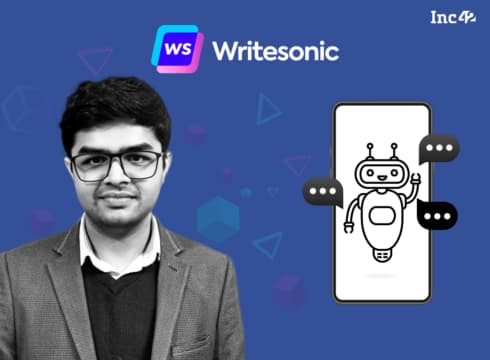Writesonic’s AI chat interface called ChatSonic is an alternative to the popular Open AI’s chatbot, but with a twist
The primary difference between ChatGPT and ChatSonic is that while the former works with a data set that dates back to 2021, the latter directly integrates Google Search to access the latest data
ChatSonic has not been designed to replace humans but to augment their capabilities, the founder said
Inc42 Daily Brief
Stay Ahead With Daily News & Analysis on India’s Tech & Startup Economy
US-based deeptech decacorn Open AI’s artificial intelligence (AI) chat interface ChatGPT is making headlines around the world for its exceptional ability to interact and respond like a human, among other things.
However, did you know that India-based Writesonic already had a similar chat interface, or chatbot, even before Open AI launched ChatGPT in November 2022.
The startup’s AI chat interface called ChatSonic is an alternative to the popular Open AI’s chatbot, but with a twist. Unlike ChatGPT, ChatSonic integrates Google Search and text-to-speech within its operation, making it efficient enough to produce the most up-to-the-minute answers to your questions.
Founded in 2021, Writesonic is a SaaS startup that primarily offers AI-powered content generation services. Writesonic’s products include ChatSonic and Photosonic, which are AI-powered tools to generate written and image content, respectively.
How ChatSonic Works?
Showing his cards, Writesonic’s founder Samanyou Garg told Inc42 that ChatSonic and ChatGPT are similar in many ways, as they both work on Open AI’s Generative Pre-trained Transformer 3 (GPT-3) language model.
“A lot of underlying tech that we use is powered by Open AI. We have been partners of Open AI for the past three years,” Garg said.
However, the primary difference between ChatGPT and ChatSonic is that while the former works with a data set that dates back to 2021, the latter directly integrates Google Search to access the latest data.
From an inexperienced eye, ChatSonic and ChatGPT could look very similar, with the only difference being that the former was launched in 2021. However, there are many differences between the two AI-driven chatbots.
For starters, ChatSonic generates up-to-date responses using Google Search. “We take the top five or 10 results from Google Search and use the information to create some new content,” explained Garg.
Apart from the integrated Google Search, ChatSonic offers other features such as text-to-speech. The chatbot also offers certain personality types for the responses. Essentially, ChatSonic’s AI will respond to the user’s questions using the word choice and semantics associated with the stereotypes associated with the personality chosen.
Garg told Inc42 that the AI chatbot can even read Excel sheets to allow users to create charts and graphs from the data. The startup has launched applications, which allow Android and iOS users to use ChatSonic on their smartphones, without a browser.
Further, Writesonic will soon be launching a Chrome extension for its chatbot that would allow users to access the interface without opening its webpage.
“We are adding ChatSonic right next to Google. This will enable ChatSonic to show you a one-two paragraph summary so that you don’t have to dig through two-three pages of Google. It would also give you the source of information,” Garg said.
AI-Generated Content: Is This The Future?
Writesonic has been targeting the AI-based content market since its inception. “What we want to do is streamline the content creation process for businesses, for individuals, for freelancers and startups,” Garg said. He added that there are no limits to the use cases, which could be developed using ChatSonic.
According to an Acumen Research and Consulting report, the generative AI market would reach $110.8 Bn in size by 2030, growing at a CAGR of 34.3%.
So far, the startup has been attracting the attention of businesses looking to streamline their content pipelines. The founder noted that over the past three-four weeks, the company has received a lot of queries from big multinational companies to use natural language processing models to create AI-generated content.
Among the many use cases that Garg told us about, the most interesting was how ChatSonic was being implemented as either a search engine for internal documents or as a customer support chatbot, competing with WhatsApp and Zoho for the latter.
Amid all the buzz about AI-generated content, there have been mentions of how AI would automate content creation, essentially putting content writers out of their jobs. The conversation has only picked up more support since the rise of ChatGPT.
However, Garg said ChatSonic would not replace any human.
“The idea here is not to replace humans but to augment their capabilities,” Garg said. He explained that Writesonic’s products could be used to reduce the time it takes to generate content.
“You’re saving 80% of the initial time with the first draft when you’re brainstorming or coming up with ideas,” he added.
Writesonic is a SaaS platform, so its earnings come from the various subscription models it offers to its users. Without revealing any key metrics, Garg said the startup has been profitable from the start and has an infinite runway.
“We don’t need the funding right now. We may take it [the funding] in a couple of months for enterprise introductions or something. But we don’t need to go for a funding round right now,” Garg said.
Interestingly, despite similarities, ChatSonic does not position itself to be a competitor of ChatGPT. However, Garg and his team seem to be building a replacement for ChatGPT. Their take on GPT-3 is very different from Open AI, and by integrating Google Search, ChatSonic might just edge out its more famous counterpart.
{{#name}}{{name}}{{/name}}{{^name}}-{{/name}}
{{#description}}{{description}}...{{/description}}{{^description}}-{{/description}}
Note: We at Inc42 take our ethics very seriously. More information about it can be found here.


